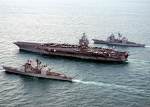U.S. Deploys Warships, Marines To Libya

Following the deaths of American ambassador to Libya J. Christopher Stevens and three members of his staff in a coordinated attack on the U.S. diplomatic mission in Benghazi on September 11, Washington is deploying two Aegis class destroyers off the coast of Libya as well as having already dispatched Marines to Benghazi and elsewhere in the nation.
The guided missile warship USS Laboon is already positioned in the Mediterranean Sea near Libya and USS McFaul is heading to the same destination from the Strait of Gibraltar. Both are equipped with Tomahawk cruise missiles, used in a massive barrage against Libya in the opening hours of so-called Operation Odyssey Dawn on March 19, 2011.
In the words of a Pentagon official cited by CNN, “These ships will give the administration flexibility” in the event Washington orders new attacks inside Libya.
According to the same American news source, “The US Navy typically keeps up to four Aegis-equipped missile warships ships in the eastern Mediterranean to aid in defending Israel and missile defense for southern Europe.”
The latter is a reference to the Obama administration’s European Phased Adaptive Approach interceptor missile system which the North Atlantic Treaty Organization announced to have achieved initial operational capability at its summit in Chicago in May. U.S. guided missile destroyers and cruisers carrying Standard Missile-3 interceptors have been active in the Mediterranean since USS Monterrey was deployed there in March of 2011, the month the U.S. and NATO began over six-months of missile and air attacks against Libya.
According to a Reuters report, eight American Marines were flown into Benghazi by helicopter the day after the attack on the U.S. mission, with two of them being killed and two wounded in a fierce mortar attack on the building.
The Associated Press claimed that the U.S. has deployed 50 members of the elite U.S. Marine Corps Fleet Antiterrorism Security Team to Libya.
U.S. Africa Command’s first war and NATO’s first war in Africa officially ended on October 31 of last year, after the U.S. and Britain launched well over 100 Tomahawk missiles into Libya and NATO followed with over 26,000 air missions, among them almost 9,000 strike sorties, in Operation Unified Protector and the nation’s leader, Muammar Gaddafi, was brutally murdered outside his hometown of Sirte.
But as with NATO’s military operations from the Balkans to Afghanistan and the Horn of Africa, one armed conflict inevitably gives way to another and the Western military bloc continues to execute plans to expand into a global military strike force.

